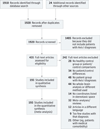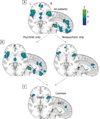Identification of a common neurobiological substrate for mental illness
- PMID: 25651064
- PMCID: PMC4791058
- DOI: 10.1001/jamapsychiatry.2014.2206
Identification of a common neurobiological substrate for mental illness
Abstract
Importance: Psychiatric diagnoses are currently distinguished based on sets of specific symptoms. However, genetic and clinical analyses find similarities across a wide variety of diagnoses, suggesting that a common neurobiological substrate may exist across mental illness.
Objective: To conduct a meta-analysis of structural neuroimaging studies across multiple psychiatric diagnoses, followed by parallel analyses of 3 large-scale healthy participant data sets to help interpret structural findings in the meta-analysis.
Data sources: PubMed was searched to identify voxel-based morphometry studies through July 2012 comparing psychiatric patients to healthy control individuals for the meta-analysis. The 3 parallel healthy participant data sets included resting-state functional magnetic resonance imaging, a database of activation foci across thousands of neuroimaging experiments, and a data set with structural imaging and cognitive task performance data.
Data extraction and synthesis: Studies were included in the meta-analysis if they reported voxel-based morphometry differences between patients with an Axis I diagnosis and control individuals in stereotactic coordinates across the whole brain, did not present predominantly in childhood, and had at least 10 studies contributing to that diagnosis (or across closely related diagnoses). The meta-analysis was conducted on peak voxel coordinates using an activation likelihood estimation approach.
Main outcomes and measures: We tested for areas of common gray matter volume increase or decrease across Axis I diagnoses, as well as areas differing between diagnoses. Follow-up analyses on other healthy participant data sets tested connectivity related to regions arising from the meta-analysis and the relationship of gray matter volume to cognition.
Results: Based on the voxel-based morphometry meta-analysis of 193 studies comprising 15 892 individuals across 6 diverse diagnostic groups (schizophrenia, bipolar disorder, depression, addiction, obsessive-compulsive disorder, and anxiety), we found that gray matter loss converged across diagnoses in 3 regions: the dorsal anterior cingulate, right insula, and left insula. By contrast, there were few diagnosis-specific effects, distinguishing only schizophrenia and depression from other diagnoses. In the parallel follow-up analyses of the 3 independent healthy participant data sets, we found that the common gray matter loss regions formed a tightly interconnected network during tasks and at resting and that lower gray matter in this network was associated with poor executive functioning.
Conclusions and revelance: We identified a concordance across psychiatric diagnoses in terms of integrity of an anterior insula/dorsal anterior cingulate-based network, which may relate to executive function deficits observed across diagnoses. This concordance provides an organizing model that emphasizes the importance of shared neural substrates across psychopathology, despite likely diverse etiologies, which is currently not an explicit component of psychiatric nosology.
Conflict of interest statement
Figures






References
-
- Spitzer RL, Endicott J, Robins E. Research diagnostic criteria: rationale and reliability. Arch Gen Psychiatry. 1978;35(6):773–782. - PubMed
-
- Fischer BA. A review of American psychiatry through its diagnoses: the history and development of the Diagnostic and Statistical Manual of Mental Disorders. J Nerv Ment Dis. 2012;200(12):1022–1030. - PubMed
-
- Ellison-Wright I, Bullmore E. Anatomy of bipolar disorder and schizophrenia: a meta-analysis. Schizophr Res. 2010;117(1):1–12. - PubMed
Publication types
MeSH terms
Grants and funding
LinkOut - more resources
Full Text Sources
Other Literature Sources
Medical

